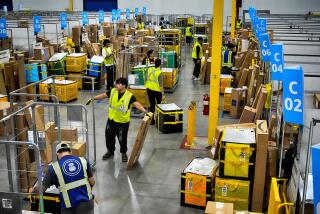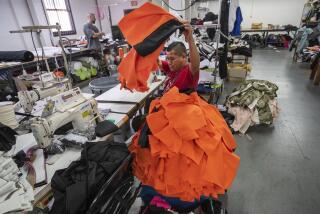Durable goods orders slip
WASHINGTON — Orders to U.S. factories for big-ticket items besides autos and airplanes showed surprising strength in April, raising hopes that manufacturing can help the economy shake off the slumping housing market and credit crisis.
Overall, orders for durable goods fell 0.5% in April, reflecting steep declines in commercial aircraft and autos, the Commerce Department reported Wednesday.
The decline, however, was one-third of what experts expected. Take out the volatile transportation sector and orders rose 2.5%, the largest gain in nine months. This reflected strength in areas including heavy machinery and primary metals such as steel, and a record surge in demand for electrical equipment and appliances.
Economists said this indicated the economy was entering the April-through-June period with some momentum in manufacturing, a sector crucial to helping keep the country from recession.
“The economy is soft, but with demand for big-ticket items holding in there, a sharp slowdown does not seem to be in the works,” said Joel Naroff, chief economist at Naroff Economic Advisors.
Many economists have worried that the economy could slip into a full-fledged downturn because of housing woes, credit tightening and soaring gasoline prices that have sent consumer confidence plunging. The Conference Board reported Tuesday that its confidence index fell in May to the lowest reading in 16 years.
Despite all the problems, overall growth has stayed in positive territory so far. The government today planned to report a revised figure for the performance of the gross domestic product in the first three months of the year. Many economists believe the initial reading for GDP growth at a 0.6% rate for January through March will now be reported at about 1%.
Although some economists are concerned that GDP could slip into negative territory in the current quarter, the durable goods report showed areas of strength. That included a 4.2% rebound in orders for nondefense capital goods excluding aircraft, considered a good proxy for business investment, which is a key GDP component.
“This is a good start for the second quarter and certainly increases the chances that this quarter will be positive,” said David Wyss, chief economist at Standard & Poor’s in New York.
Analysts said manufacturing was benefiting from strong export demand.
U.S. manufacturers are getting a boost from the weaker dollar, which makes their products cheaper in overseas markets, and from the fact that businesses did not go on an investment-spending binge before the current slowdown.
More to Read
Inside the business of entertainment
The Wide Shot brings you news, analysis and insights on everything from streaming wars to production — and what it all means for the future.
You may occasionally receive promotional content from the Los Angeles Times.










